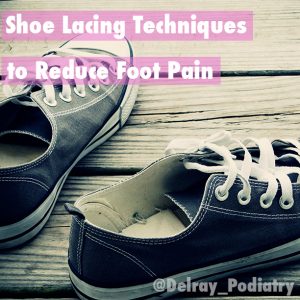After years of relying on bunny ears and loop-dee-loops, the emergence of foot and ankle pain can often lead to taking a more serious, calculated approach to tying your shoes later in life.
Whether you have narrow, wide, or high arched feet, or if you are experiencing foot pain, a change to your lacing technique may help you.
In fact, not only can certain lacing techniques safeguard against injuries, but they can also help alleviate pain and relieve a variety foot problems.
If you are currently suffering from foot pain, check out these lacing techniques to get a better fit with your shoe:
— Always loosen the laces on your shoes before sliding your foot into them. This prevents unnecessary stress on the small holes the laces go through — also known as eyelets — as well as the backs of the shoes.
— Always begin lacing shoes at the eyelets closest to your toes, pulling the laces tightly after each set to provide a tight, comfortable shoe fit.
— If comfort is your goal, always remember that shoes with a larger number of eyelets will make it easier to adjust laces for a custom fit.
— A simple crisscross method works best for the majority of people when it comes to tying their shoes, however, there are numerous lacing variations that can be used to deal with specific issues.
Heel Problems
In order to prevent heel problems, it is important to utilize every eyelet on the shoe to make sure the heel is tied tightly and there is less tension near the toes. When you get to the last eyelet on each side, thread the lace through the top eyelet, making a small loop. Then, thread the other lace through each loop before tying it.
If you prefer to simply keep your heels from slipping, however, crisscross your laces normally and form a lock lace when you reach the top. If you feel that your foot is moving around too much at the forefoot, add a lock lace there. If you’re slipping in the heel, put one at the top.
Wide Feet
If you have wider feet, use the eyelets closest to the tongue of the shoe. This technique gives your toes and forefoot more room to breathe in the front of the shoe.
If you have a bunion, this method can also typically make shoes feel more comfortable.
Narrow Feet
If you have narrow feet, use the eyelets farthest from the tongue of the shoe.
This method will bring up the side of the shoe, which hug your narrow feet for a better tighter and more comfortable fit.
Narrow Heel and Wide Forefoot
Sometimes one pair of laces simply isn’t enough! If you have a narrow heel and ankle with a wide forefoot, consider using two laces per shoe to achieve a combination fit.
Thread one lace through the top half of the eyelets and the other lace through the bottom half of the eyelets. In this case, the lace closest to the heel should be tied more tightly than the other lace closest to the toes.
—
Follow Delray Beach Podiatry on Twitter @Delray_Podiatry
The content on this website is for informational purposes only. Do not rely or act upon information from www.DelrayBeachPodiatry.com without seeking professional medical advice. If you live in South Florida and would like a consultation with Dr. Ian Goldbaum, a podiatric physician and surgeon with over 30 years of experience, please see our contact information below:
BOCA/DELRAY
16244 S. Military Trail #290, Delray Beach, FL 33445
561-499-0033
BOYNTON BEACH
8198 Jog Road #100, Boynton Beach, FL 33472
561-499-0033


No responses yet